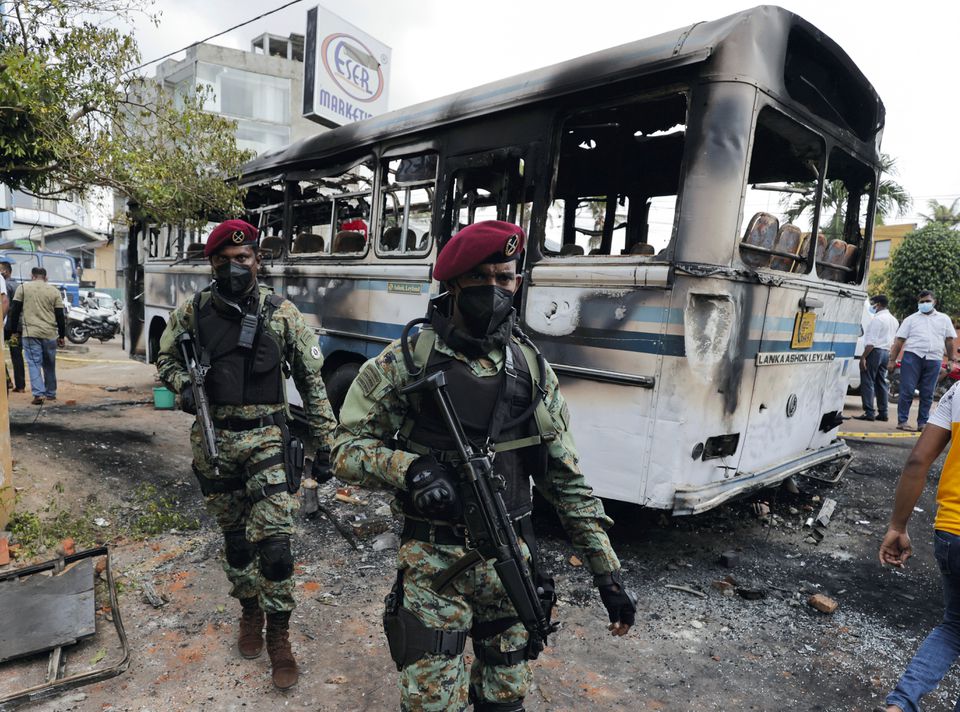The Sri Lankan government has imposed a nationwide emergency to curb violence over an unprecedented economic collapse that has overtaken the island country. Later, a 36-hour curfew was ordered from April 2, blocking access to social media purportedly to pre-empt violence. These are all retrograde steps taken to stave off a crisis precipitated by the ruling family, the members of which occupy top posts of President, Prime Minister and Finance Minister, besides allocating among themselves several key portfolios. The collapse of economic life in Sri Lanka is the outcome of mismanagement for the past few years that assumed alarming proportions under the current dispensation.
President Gotabaya Rajapaksa declared nationwide public emergency following violent protests over the country’s worst economic crisis in decades. He said in a government gazette notification late April 1 that he took the decision in the interests of public security, the protection of public order and the maintenance of supplies and essential services. Hundreds of protesters had clashed the previous day outside Rajapaksa’s residence in a suburb of the capital, Colombo. While the government claimed the protests were taken over by anti-social elements, protesters said violence erupted only after the police used tear gas, water cannons and beat them up. The curfew was then resorted to in order to contain sporadic protests that have broken out over shortages of essential items, including fuel, rice, milk powder, medicines and other goods. One tell-tale indication of the economic crisis and the government’s failure to handle it is that the people are being subjected to long blackouts that extend to many hours every day as the government does not have enough foreign exchange to pay fuel imports needed for running power plants.
The country’s lucrative tourism industry and foreign workers’ remittances have been hard hit by the COVID-19 pandemic. The problem has been compounded by deep tax cuts and the decision to ban fertilisers that severely affected agriculture production. The result was that ordinary Sri Lankans are being forced to live with shortages and soaring inflation. Faced with the grave situation, an alliance of 11 political parties urged Rajapaksa to dissolve the cabinet and form a government with all parties to deal with the crisis, but the latter spurned the suggestion.
The weak kneed actions of previous governments helped the Rajapaksa family which swept to power in 2019 promising strong leadership and decisive action. But the new government seems to have failed the nation. The administration which is a monopoly of the ruling family is solely responsible for populist measures such as a huge raise in the threshold for income tax and VAT registration that led to revenue loss. The order to take to fertiliser-free farming overnight and a ban on chemical fertilisers caused serious loss of yield. Though subsequently, the ban was lifted, it has taken its toll on food security. People have become hostile to the government for the apathy of the ruling family, its profligacy and mishandling of the monetary policy.
Sri Lanka largely depends on imports, while it gains its foreign exchange through tourism, the export of garments and tea and external remittances. The Easter Sunday blasts of 2019 put off tourists from visiting the country hitting the tourism sector hard. For some time, Sri Lanka has been trying to cope with the crisis with assistance amounting to $2.40 billion from India and also from China. Realising that this is not enough, the country has decided to shake off its inhibitions against International Monetary Fund (IMF) loans and a move is on to get a bailout package from the IMF despite the conditions attached. The government’s refusal to admit there is a deep crisis is not the right approach to salvage the economy.
Since the island country is moving towards insolvency, experts point out the Sri Lankan government needs to take adequate policies to curb imports, at least for the time being. This is to save precious foreign reserves. Its foreign reserves are close to $2 billion, but less than $1 billion is actually available because of repayment schedules of loans and sovereign bonds. The primary reason for the crisis seems to be policy paralysis where the government ignored signs leading to the collapse of its financial set-up.
In the present crisis of Sri Lanka lies a great lesson for India. It is not only Sri Lanka but Pakistan also is in a political turmoil because of economic mismanagement. India must realize that it too can fall into a similar situation very easily. Here in India, the government has tried to mess with time tested agricultural systems and although, under pressure from protesting farmers, some related laws were withdrawn, the mindset of those who govern remains the same. Similarly, economic actions such as Demonetization, introduction of GST and most importantly the sweeping changes being carried out in the banking sector along with disposal of invaluable government assets to select industrial houses could result in the Indian economy going into a tailspin. It would be wrong to assume that the size and magnitude of India would ensure a healthy future. It might be just that very size and magnitude that would be responsible for a crisis to be born.
